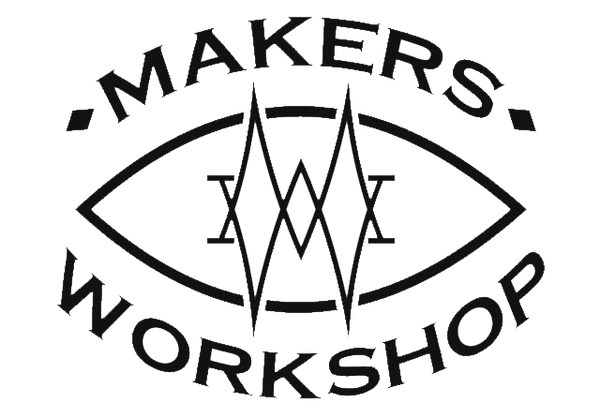I put together the first iteration of this design in Adobe Illustrator. I like to jump into a first draft pretty quickly because it gets me out of my head and starts the creative process. I threw together 4 rectangles that were about the size I thought I wanted, and then 4 triangles.
I cut out a small version of the design on our glowforge laser cutter in cardboard, and then I started taping it together to get a sense of how it would look as a 3D piece.
This ended up taking about three prototypes before I was happy with it.
We don’t have a CNC plasma cutter at Maker’s Workshop, so I sent the design over to our friend Richard at 42 Fab who agreed he would cut this for me. A CNC plasma cutter is a pretty similar machine to a laser cutter, the difference being that it move around a plasma cutter, not a laser, which can easily cut through steel. It’s cool to watch work because it makes steel sheets look like butter, all with a high level of precision.
Richard lives in Oklahoma and we are in Massachusetts, so I needed to wait for it to come in the mail. He got it back to me so much quicker than I expected, and I barely had to wait. I also asked him to cut 2 smaller lanterns, which he agreed to, which was awesome.
I cleaned off the steel with acetone to prep it to be welded. I started with a tack weld in the middle, and then one at each end to distribute the heat. I then split the difference with 2 more tacks. This was a great part of the process because tacking goes quickly, and I could see the lantern take shape in minutes.
I perched the roof pieces on top of 2 magnetic squares, making sure I had a right angle on the top rim. This method, while not technically perfect, did produce a pretty square roof. The floor was the last thing to install with tacks before I started running full beads along each seam.
I spent the next day running full beads on all of my seams, and assembling 2 smaller versions of my design. Because it takes a good amount of focus, welding feels meditative to me; Time flies by.
The next step was hitting each seam with the angle grinder. Grinding easily took up the bulk of the time in this build.
I also took a minute to patch up a few holes some of my first welds. One of them was a hole in one of the smaller lantern’s roof’s, which I repaired by placing a few tacks on the perimeter and waiting for them to cool completely before adding more tacks. This took some patience, but worked like a charm to completely fill the hole.
The next thing I needed to do was cutting angle iron into 1-inch pieces using a chop saw. These would be used to elevate the roof and allow the lantern to vent smoke. I carefully positioned each piece of angle iron the corners of the lantern, and welded them into place. A simple design change would eliminate the need for the angle iron here, but this method did work very well. I also attached the bottom roof section with angle iron on top to support the top roof section.
I used painter’s tape to hold things together while welding the roof on. I tacked from the outside so I could visually get things exactly how I wanted, and then ran my beads from the inside where it was easier to access.
I wasn’t 100% satisfied with my corners, so I mixed up some bondo and placed it on my corners as needed. Once it had set for about 15 minutes, I was able to easily sand it down by hand into some more precise corners.
Then, I covered all sides with a sandable primer to lay the groundwork for a finished paint job.
I then needed to install the door and hinges on the lanterns. I traced where the holes needed to be before drilling on all 3 lanterns. I then installed the hardware with a few small bolts.
I then did my final paint job. I used an indoor/outdoor matte black paint meant for grilles. For this project it worked perfectly.
For the door latch, I wanted a sleek look, so I decided to use 2 rare earth magnets. It worked like a charm.
All that was left was popping some candles in and enjoying the finished piece.
